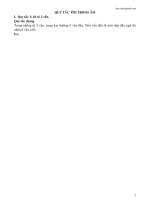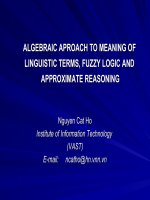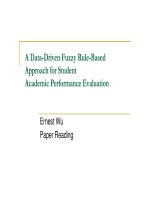Fuzzy rules fuzzy reasoning
Bạn đang xem bản rút gọn của tài liệu. Xem và tải ngay bản đầy đủ của tài liệu tại đây (339.46 KB, 38 trang )
Fuzzy Rules and Fuzzy Reasoning
Chap 3: Fuzzy Rules
and Fuzzy Reasoning
Outline
Extension principle
Fuzzy relations – linguistic variable, linguistic
value
Fuzzy if-then rules – other aspect of fuzzy
relations
Compositional rule of inference
Fuzzy reasoning
Extension Principle
• A general procedure for extending crisp domains
of mathematical expressions to fuzzy domains.
• Fuzzifying crisp functions is called an extension
principle.
Extension Principle
A is a fuzzy set on X :
A = µ A ( x1 ) / x1 + µ A ( x2 ) / x2 ++ µ A ( x n ) / x n
The image of A under f( ) is a fuzzy set B = f(A):
B = µ B ( x1 ) / y1 + µ B ( x2 ) / y2 ++ µ B ( x n ) / y n
where yi = f(xi), i = 1 to n.
If f( ) is a many-to-one mapping, then
µ B ( y ) = max µ A ( x )
x= f
−1
( y)
Example
Application of the extension principle to
fuzzy sets with discrete universes
Let A = 0.1 / -2+0.4 / -1+0.8 / 0+0.9 / 1+0.3 / 2
and f(x) = x2 – 3
Applying the extension principle, we obtain:
B = 0.1 / 1+0.4 / -2+0.8 / -3+0.9 / -2+0.3 /1
= 0.8 / -3+(0.4V0.9) / -2+(0.1V0.3) / 1
= 0.8 / -3+0.9 / -2+0.3 / 1
where “V” represents the “max” operator
- Same reasoning for continuous universes
Fuzzy Relations – fuzzy set with various
dimensional membership function
A fuzzy relation R is a 2D MF:
R = {(( x , y ), µ R ( x , y ))|( x , y ) ∈ X × Y}
Examples:
• x is close to y (x and y are numbers)
• x depends on y (x and y are events)
• x and y look alike (x, and y are
persons or objects)
• If x is large, then y is small (x is an
observed reading and Y is a
corresponding action)
Examples
- Let X = Y = IR+
and R(x,y) = “y is much greater than x”
The MF of this fuzzy relation can be subjectively
defined as:
y−x
, if y > x
µ R ( x, y ) = x + y + 2
0
, if y ≤ x
if X = {3,4,5} & Y = {3,4,5,6,7}
Then R can be Written as a matrix:
0 0.111 0.200 0.273 0.333
R = 0 0 0.091 0.167 0.231
0
0.077 0.143
0 0
where R{i,j} = µ[xi, yj]
– x is close to y (x and y are numbers)
– x depends on y (x and y are events)
– x and y look alike (x and y are persons or objects)
– If x is large, then y is small (x is an observed
reading and Y is a corresponding action)
Max-Min Composition
The max-min composition of two fuzzy relations R1 (defined on X and Y) and R2 (defined on Y and Z) is
Properties:
• Associativity:
• Distributivity over union:
• Week distributivity over intersection:
• Monotonicity:
µ R1 R2 ( x , z ) = ∨[µ R1 ( x , y ) ∧ µ R2 ( y , z )]
y
R (S T ) = ( R S ) T
R (S T ) = ( R S ) ( R T )
R ( S T ) ⊆ ( R S ) ( R T )
S ⊆ T ⇒ (R S) ⊆ (R T )
Max-Star Composition
In general, we have max-* composition:
where * is a T-norm operator.
For Example,
µ R R ( x , z ) = ∨[µ R ( x , y ) * µ R ( y , z )]
Max-product composition:
1
2
1
y
2
µ R R ( x , z ) = ∨[µ R ( x , y )µ R ( y , z )]
1
2
y
1
2
Example of max-min & max-product composition
• Let R1 = “x is relevant to y”
R2 = “y is relevant to z”
be two fuzzy relations defined on
X*Y and Y*Z respectively
X = {1,2,3}, Y = {α,β,χ,δ} and Z =
{a,b}.
Assume that:
0.1 0.3
0.5 0.7
R 1 = 0.4 0.2 0.8 0.9
0.6 0.8 0.3 0.2
0.9
0.2
R2 =
0.5
0.7
0.1
0.3
0.6
0.2
The derived fuzzy relation “x is relevant to
z” based on R1 & R2
Let’s assume that we want to compute the
degree of relevance between 2 ∈ X & a ∈
Z
Using
µ max-min,
( 2, a ) = max{we
0.4 ∧obtain:
0.9,0.2 ∧ 0.2,0.8 ∧ 0.5,0.9 ∧ 0.7}
R1 R 2
= max{ 0.4,0.2,0.5,0.7}
= 0.7
µ R1max-product
* 0.9,0.2 * 0.2,0.8 * 0we
.5,0.9obtain:
* 0.7}
Using
R 2 ( 2, a ) = max{ 0.4composition,
= max{ 0.36,0.04,0.40,0.63}
= 0.63
Linguistic Variables
• Conventional techniques for system analysis are
intrinsically unsuited for dealing with systems
based on human judgment, perception &
emotion
• Principle of incompatibility
- As the complexity of a system increases, our ability
to make precise & yet significant statements about
its behavior decreases until a fixed threshold
- Beyond this threshold, precision & significance
become almost mutually exclusive characteristics
[Zadeh, 1973]
• The concept of linguistic variables introduced by
Zadeh is an alternative approach to modeling
human thinking
• Information is expressed in terms of fuzzy sets
instead of crisp numbers
Definition: A linguistic variable is a quintuple
(x, T(x), X, G, M) where:
-
x is the name of the variable
T(x) is the set of linguistic values (or terms)
X is the universe of discourse
G is a syntactic rule that generates the linguistic values
M is a semantic rule which provides meanings for the
linguistic values
Linguistic Variables
A numerical variables takes numerical values:
Age = 65
A linguistic variables takes linguistic values:
Age is old
A linguistic values is a fuzzy set.
All linguistic values form a term set:
T(age) = {young, not young, very young, ...
middle aged, not middle aged, ...
old, not old, very old, more or less old, ...
not very yound and not very old, ...}
- Where each term T(age) is characterized by a
fuzzy set of a universe of discourse X= =
[0,100]
• The syntactic rule refers to the way the
terms in T(age) are generated
• The semantic rule defines the
membership function of each linguistic
value of the term set
• The term set consists of primary terms
as (young, middle aged, old) modified
by the negation (“not”) and/or the
hedges (very, more or less, quite,
extremely,…) and linked by connectives
such as (and, or, either, neither,…)
Operations on Linguistic Values
Concentration:
CON ( A) = A2
Dilation:
DIL( A) = A0.5
Contrast
0 ≤ µ A ( x ) ≤ 0.5
2 A2 ,
INT ( A) =
2
¬
2
(
¬
A
)
, 0.5 ≤ µ A ( x ) ≤ 1
intensification:
intensif.m
Concentration & dilation of
linguistic values
- Let A be a linguistic value described by a fuzzy
set with membership function µA(.)
A k = ∫ [µ A ( x )]k / x
X
– A2 = CON(A) is called the concentration operation
√A = DIL(A) is called the dilation operation
– CON(A) & DIL(A) are useful in expression the hedges
such as “very” & “more or less” in the linguistic term A
– Other definitions for linguistic hedges are also possible
Composite linguistic terms
Let’s define:
NOT( A ) = ¬A = ∫ [1 − µ A ( x )] / x,
X
A and B = A ∩ B = ∫ [µ A ( x ) ∧ µ B ( x)] / x
X
A or B = A ∪ B = ∫ [µ A ( x ) ∨ µ B ( x )] / x
X
where A, B are two linguistic values whose
semantics are respectively defined by µ A(.) &
µ B(.)
Composite linguistic terms such as: “not very
young”, “not very old” & “young but not too
young” can be easily characterized
Example: Construction of MFs for composite
linguistic terms
Let’s
µ young ( x ) = bell( x,20,2,0) =
µ old ( x ) = bell( x,30,3,100) =
1
x
1+
20
1
4
x − 100
1+
30
6
Where x is the age of a person in the
universe of discourse
1
/x
[0, 100]
∫
6
x − 100
X
1=
+
More or less = DIL(old) = √old
30
Not young and not old = ¬young ∩ ¬old =
1
1
∧ 1 −
/x
∫ 1 −
4
6
x
x − 100
X
1+ 1+
20
30
2
Young but not too young = young
∩
¬young
2
(too = very) =
1
1
∧ 1 −
∫
4
4
x x
x
1+
1 +
20 20
/x
Extremely old ≡ very very very old = CON
8
(CON(CON(old))) =
1
∫ x − 100 6 / x
x
1 +
30
Linguistic Values (Terms)
complv.m
• Contrast intensification
the operation of contrast intensification
on a linguistic value A is defined by
2 A 2 if 0 ≤ µ A ( x) ≤ 0.5
INT( A ) =
¬2( ¬A ) 2 if 0.5 ≤ µ A ( x ) ≤ 1
- INT increases the values of µA(x) which are
greater than 0.5 & decreases those which
are less than or equal to 0.5
- Contrast intensification has effect of
reducing the fuzziness of the linguistic value
A
Orthogonality
A term set T = t1,…, tn of a linguistic
variable x on the universe X is
orthogonal if:
n
∑ µ t i (x) = 1,
∀x ∈ X
i =1
Where the ti’s are convex & normal
fuzzy sets defined on X.









